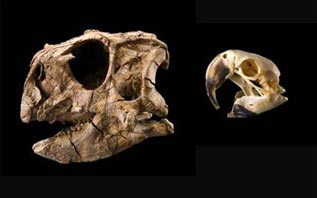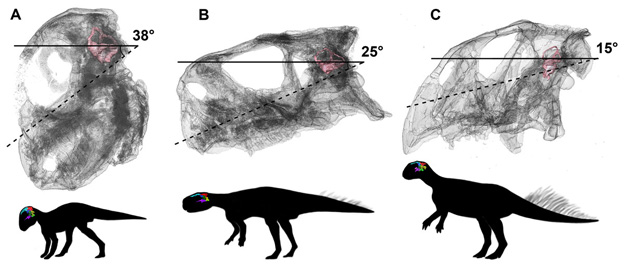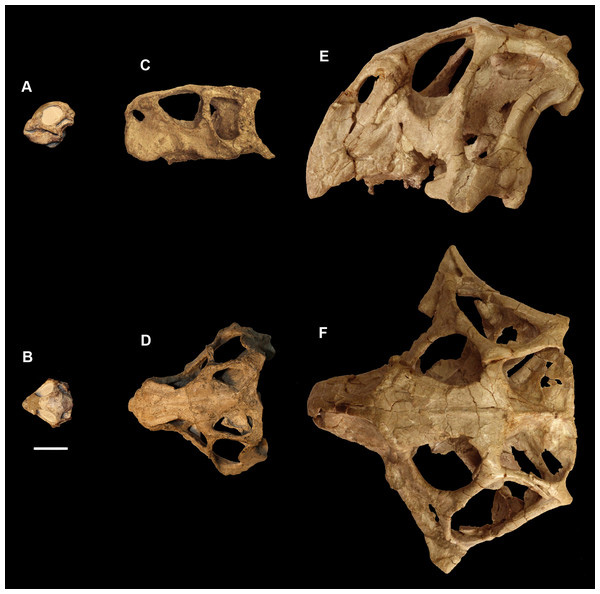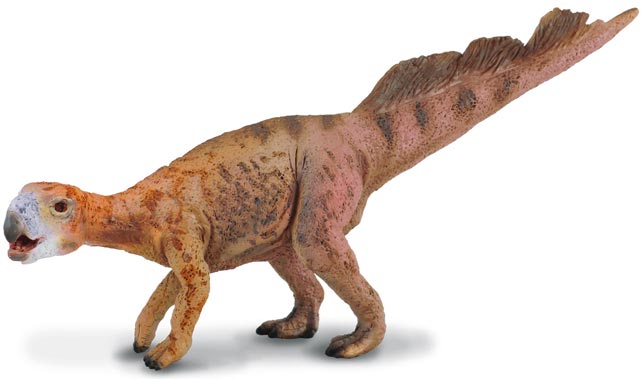Picking the Brains of Psittacosaurus
Psittacosaurus Gets its Head Examined
Researchers from the Chinese Academy of Sciences, in collaboration with colleagues from Carleton University (Ottawa, Canada) and Bristol University, have produced a new study on the Early Cretaceous Asian dinosaur Psittacosaurus (P. lujiatunensis). This new research, published in PeerJ, provides the first detailed survey of Ceratopsian braincase changes as a dinosaur grows.
Three growth stages were studied – hatching, juvenile and adult and as Psittacosaurus got bigger, so its brain changed in shape. Furthermore, the study suggests that these little, herbivorous dinosaurs changed posture as the aged. When young they were facultative quadrupeds, but as they matured they favoured a bipedal stance.
Psittacosaurus Gets Its Head Examined
Hundreds of Psittacosaurus Specimens Examined
Hundreds of Psittacosaurus fossil specimens were examined. These fossils herald from the Early Cretaceous (Barremian–Aptian) of China, specifically from the Yixian Formation. The lack of fossils representing dinosaurs at different growth stages limits ontogenetic studies, but Psittacosaurus is an exception, it is one of the better represented members of the Ornithischia. The cranial and endocranial morphology of Psittacosaurus has been well documented, but only cursory details have been published on the bones surrounding the brain.
Comparing Skulls Psittacosaurus “Parrot Lizard” Compared to a Parrot

Picture credit: Mike Hettwer
From Hamster-sized Hatchlings to Two-metre-long Adults
From hamster-sized babies these dinosaurs grew relatively quickly into two-metre-long adults. As they grew, their brain changed in shape from being crammed into the back of the head, behind the huge eyes in the hatchling, to being longer, and extending under the skull roof in the adult animals. The braincase provides evidence that supports the idea that these dinosaurs changed posture as they got older. The position and the orientation of the semi-circular canals, which helped these dinosaurs with their balance, changed as they grew.
Corresponding author of the paper, Claire Bullar (University of Bristol School of Earth Sciences), commented:
“I was excited to see that the orientation of the semi-circular canals changes to show this posture switch. The semi-circular canals are the structures inside our ears that help us keep balance, and the so-called horizontal semi-circular canal should be just that – horizontal – when the animal is standing in its normal posture. This is just what we see, with the head of Psittacosaurus pointing down and forwards when it was a baby – just right for moving on all-fours. Then, in the teen or adult, we see the head points exactly forwards, and not downwards, just right for a biped.”
Dinosaur Brains from Baby to Adult (left to right)

Picture credit: Claire Bullar/Institute of Vertebrate Palaeontology and Palaeoanthropology
Changing Postures
The change in posture is supported by postcranial fossil evidence. The relative limb lengths indicate that a juvenile Psittacosaurus would have moved around on four legs, but by the age of two or three, they switched to a bipedal posture, standing upright on their elongate hind legs. This would have freed up the arms and hands to help with gathering food. The team used reconstructions created from micro-computed tomography scans of well-preserved skulls to plot the ontogenetic changes.
Co-supervisor Dr Qi Zhao from the Institute of Vertebrate Palaeontology and Palaeoanthropology (IVPP) in Beijing, where the specimens are housed, added:
“It’s great to see our idea of posture shift confirmed, and in such a clear-cut way, from the orientation of the horizontal ear canal. It’s also amazing to see the results of high-quality CT scanning in Beijing and the technical work by Claire to get the best 3-D models from these scan data.”
Skulls of Psittacosaurus (P. lujiatunensis) Showing Different Growth Stages

Picture credit: Claire Bullar/Institute of Vertebrate Palaeontology and Palaeoanthropology
Psittacosaurus and the Posture Shift
Co-author Professor Michael Ryan (Carleton University) contributed:
“This posture shift during growth from quadruped to biped is unusual for dinosaurs, or indeed any animal. Among dinosaurs, it’s more usual to go the other way, to start out as a bipedal baby, and then go down on all fours as you get really huge. Of course, adult Psittacosaurus were not so huge, and the shift maybe reflects different modes of life: the babies were small and vulnerable and so probably hid in the undergrowth, whereas bipedalism allowed the adults to run faster and escape their predators.”
Professor Michael Benton (Bristol University), another collaborator in this study commented:
“This is a great example of classic, thorough anatomical work, but also an excellent example of international collaboration.”
Everything Dinosaur acknowledges the assistance of a press release from Bristol University in the compilation of this article.
The scientific paper: “Ontogenetic braincase development in Psittacosaurus lujiatunensis (Dinosauria: Ceratopsia) using micro-computed tomography” by C. Bullar, Q. Zhao, M. Benton and M. Ryan in PeerJ — the Journal of Life and Environmental Sciences.
The Everything Dinosaur website: Everything Dinosaur.


